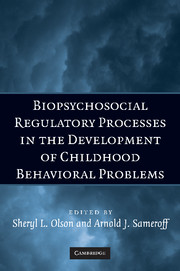Book contents
- Frontmatter
- Contents
- Preface
- Contributors
- 1 Conceptual Issues in Studying the Development of Self-Regulation
- 2 How Gene-Environment Interactions Can Influence the Development of Emotion Regulation in Rhesus Monkeys
- 3 Context Matters: Exploring Definitions of a Poorly Modulated Stress Response
- 4 An Integrative Approach to the Neurophysiology of Emotion Regulation: The Case of Social Withdrawal
- 5 Regulatory Competence and Early Disruptive Behavior Problems: The Role of Physiological Regulation
- 6 Behavior Regulation as a Product of Temperament and Environment
- 7 Self-Regulatory Processes in the Development of Disruptive Behavior Problems: The Preschool-to-School Transition
- 8 Emotional Dysregulation and the Development of Serious Misconduct
- 9 Regulatory Processes in Children's Coping with Exposure to Marital Conflict
- 10 Family Subsystems and Children's Self-Regulation
- 11 Culture and the Development of Regulatory Competence: Chinese–U.S. Comparisons
- 12 Self-Regulation and the Development of Behavioral and Emotional Problems: Toward an Integrative Conceptual and Translational Research Agenda
- Index
- References
11 - Culture and the Development of Regulatory Competence: Chinese–U.S. Comparisons
Published online by Cambridge University Press: 02 July 2009
- Frontmatter
- Contents
- Preface
- Contributors
- 1 Conceptual Issues in Studying the Development of Self-Regulation
- 2 How Gene-Environment Interactions Can Influence the Development of Emotion Regulation in Rhesus Monkeys
- 3 Context Matters: Exploring Definitions of a Poorly Modulated Stress Response
- 4 An Integrative Approach to the Neurophysiology of Emotion Regulation: The Case of Social Withdrawal
- 5 Regulatory Competence and Early Disruptive Behavior Problems: The Role of Physiological Regulation
- 6 Behavior Regulation as a Product of Temperament and Environment
- 7 Self-Regulatory Processes in the Development of Disruptive Behavior Problems: The Preschool-to-School Transition
- 8 Emotional Dysregulation and the Development of Serious Misconduct
- 9 Regulatory Processes in Children's Coping with Exposure to Marital Conflict
- 10 Family Subsystems and Children's Self-Regulation
- 11 Culture and the Development of Regulatory Competence: Chinese–U.S. Comparisons
- 12 Self-Regulation and the Development of Behavioral and Emotional Problems: Toward an Integrative Conceptual and Translational Research Agenda
- Index
- References
Summary
One of the most stunning demonstrations of differences in behavior regulation across cultures can be found by simply walking into preschool or early elementary classrooms in Chinese societies (including Hong Kong, Taiwan, and Singapore) versus those in the United States. Before even making it to the center of the classroom, one is immediately struck by the differences – found in classroom after classroom, school after school – in the appearance of the “cubbies” and other entry areas. In both Chinese and American preschools, children have cubbies in which they can place their personal belongings (school bags and the like) and outdoor clothing. In both, these cubbies tend to be arranged as a line of boxes or hooks on a wall near the entrance to the room. In both, there are names and pictures of the children on the cubbies in addition to their belongings. When empty, they are almost identical.
But from the minute the first child arrives at school, the differences begin to appear, and they magnify with each additional child who comes into the classroom. What is the difference? In the few seconds (this rarely lasts even as long as a minute in either place) between parents dropping off their child and the child entering into the classroom proper, children's belongings get placed in the cubby.
- Type
- Chapter
- Information
- Biopsychosocial Regulatory Processes in the Development of Childhood Behavioral Problems , pp. 258 - 289Publisher: Cambridge University PressPrint publication year: 2009
References
- 13
- Cited by



